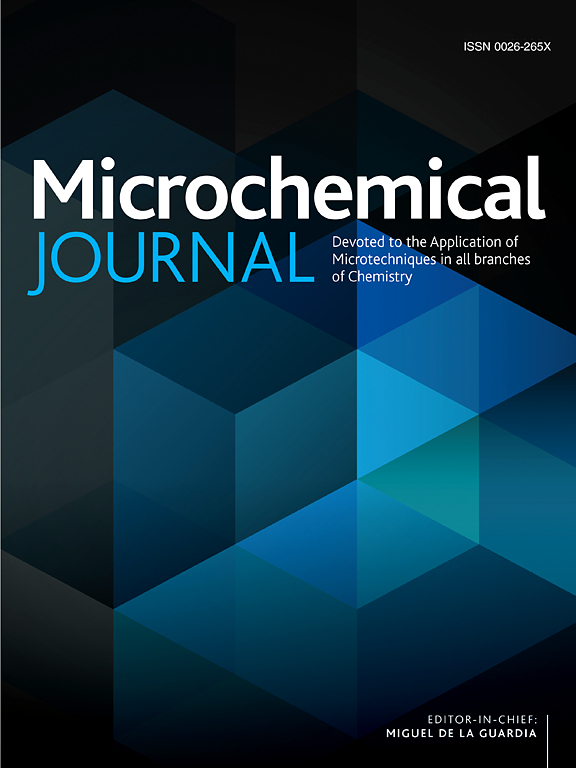Eco-friendly and Stability-Indicating RP-HPLC method for simultaneous estimation of Fluconazole and Tinidazole in combined dosage form
IF 4.9
2区 化学
Q1 CHEMISTRY, ANALYTICAL
引用次数: 0
Abstract
A stability-indicating RP-HPLC method has been developed and validated for the simultaneous estimation of Fluconazole, its associated organic impurities and Tinidazole in a combined dosage form by implementing isocratic reverse-phase high-performance liquid chromatography (RP-HPLC). These combined dosage forms were simultaneously estimated and related impurities were summarized using an RP-HPLC system with water: Isopropyl alcohol (IPA) (80:20) as the eluting solvent. The stationary phase of Zorbax SB C8 column (150 mm × 4.6 mm, 3.5 μm) was utilized for elution. The method reveals prominent RT of Fluconazole, its related impurities A, B, or C and Tinidazole were found at 3.0, 2.5, 2.8, 6.8 and 2.2 min correspondingly. Validation and impurity profiling parameters were done with adherence to the International Conference on Harmonization (ICH) and United States Pharmacopeia (USP). For both Fluconazole and Tinidazole, detector response has been confirmed to be linear with concentration in the 22.5–135 µg/mL range. The LOD and LOQ for Fluconazole have been 0.054 µg/ml, 0.163 µg/ml and for Tinidazole have been 0.127 µg/ml, and 0.387 µg/ml respectively. The % recovery of 99.5 % and 100.9 % was achieved for Fluconazole and Tinidazole through the assay method with compliance with % RSD of 0.23 % and 0.14 % for six preparations. The forced degradation studies show that Fluconazole and Tinidazole showed well-resolved peaks derived from the drug active ingredient. Finally, the developed method was found to be simple, precise, accurate, and eco-friendly as assessed by greenness using three factors. The developed method is simple, reliable, and prominent for regular adoption of quality control analysis.
环保稳定指示型反相高效液相色谱法同时测定氟康唑和替硝唑联合剂型的含量
建立了一种稳定性指示的反相高效液相色谱(RP-HPLC)方法,用于同时测定氟康唑及其相关有机杂质和替硝唑的联合剂型。以水:异丙醇(IPA)(80:20)为洗脱溶剂,采用反相高效液相色谱(RP-HPLC)体系,同时对这些组合剂型进行了估算,并对相关杂质进行了总结。采用Zorbax SB C8色谱柱(150 mm × 4.6 mm, 3.5 μm)固定相进行洗脱。结果表明,氟康唑的RT值显著,其相关杂质A、B、C和替硝唑的RT值分别为3.0、2.5、2.8、6.8和2.2 min。根据国际统一会议(ICH)和美国药典(USP)进行验证和杂质分析参数。对于氟康唑和替硝唑,在22.5 ~ 135µg/mL范围内,检测器响应与浓度呈线性关系。氟康唑的检出限和定量限分别为0.054µg/ml、0.163µg/ml和替硝唑的检出限分别为0.127µg/ml和0.387µg/ml。氟康唑和替硝唑的回收率分别为99.5%和100.9%,6种制剂的RSD分别为0.23%和0.14%。强制降解研究表明,氟康唑和替硝唑均表现出由药物活性成分衍生的高分辨峰。结果表明,该方法具有简单、精确、准确和生态友好的特点。所建立的方法简便、可靠,适合定期采用质量控制分析。
本文章由计算机程序翻译,如有差异,请以英文原文为准。
求助全文
约1分钟内获得全文
求助全文
来源期刊

Microchemical Journal
化学-分析化学
CiteScore
8.70
自引率
8.30%
发文量
1131
审稿时长
1.9 months
期刊介绍:
The Microchemical Journal is a peer reviewed journal devoted to all aspects and phases of analytical chemistry and chemical analysis. The Microchemical Journal publishes articles which are at the forefront of modern analytical chemistry and cover innovations in the techniques to the finest possible limits. This includes fundamental aspects, instrumentation, new developments, innovative and novel methods and applications including environmental and clinical field.
Traditional classical analytical methods such as spectrophotometry and titrimetry as well as established instrumentation methods such as flame and graphite furnace atomic absorption spectrometry, gas chromatography, and modified glassy or carbon electrode electrochemical methods will be considered, provided they show significant improvements and novelty compared to the established methods.
 求助内容:
求助内容: 应助结果提醒方式:
应助结果提醒方式:


